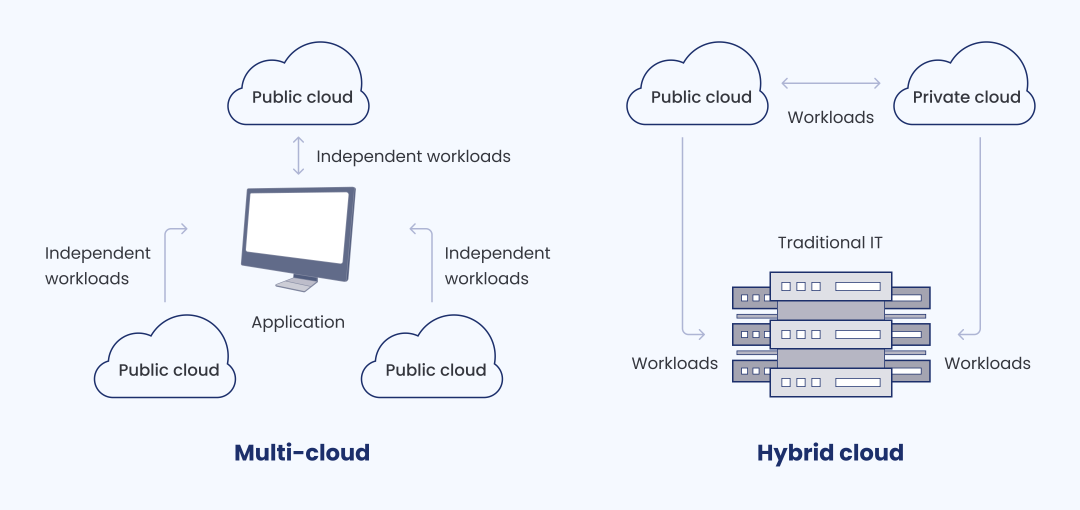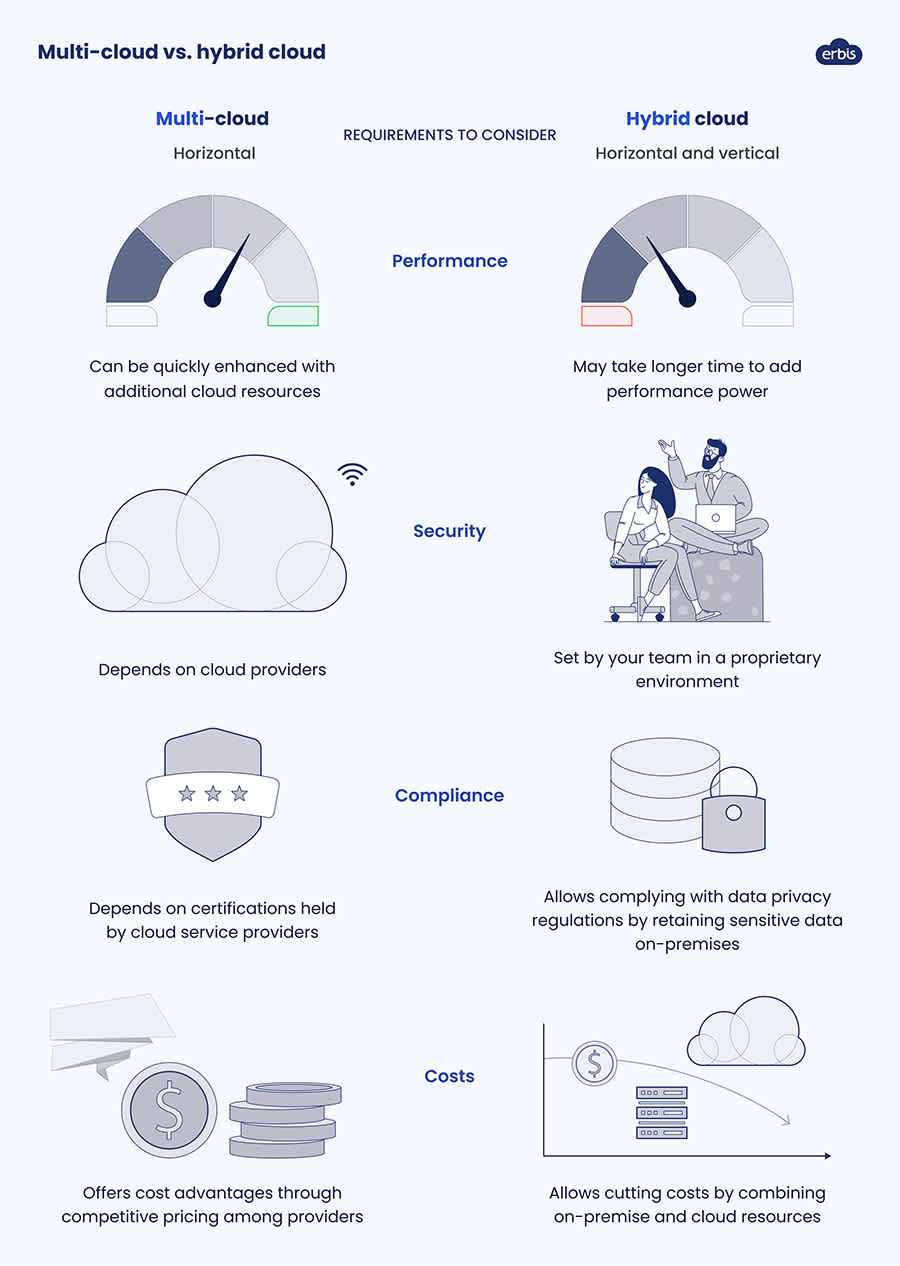Multi-Cloud vs. Hybrid Cloud: Choosing the Right Infrastructure For Your Project
The digital age has brought about a significant change for businesses with the rise of cloud computing solutions. As more organizations use the cloud for their infrastructure setup, the debate between multi-cloud vs. hybrid cloud approaches has become more important. In this article, we will explain the intricacies of these two cloud models to help you make an informed decision for your project.
Multi-cloud vs hybrid cloud: understanding the basics
Multi-cloud and hybrid cloud are two prevalent models that often come into consideration when selecting IT infrastructure.
Multi-cloud infrastructure: definition and characteristics
Multi-cloud means using the services from multiple cloud service providers. This approach allows for distributing workloads across different cloud environments and mitigating reliance on a single vendor. Organizations adopting the multi-cloud model leverage a mix of public cloud services, such as Amazon Web Services (AWS), Microsoft Azure, and Google Cloud Platform (GCP).
Multi-cloud strategy allows you to cherry-pick the best services from different providers based on their strengths. For instance, you might opt for AWS for its robust infrastructure while relying on Azure for specialized AI tools. This diversification minimizes dependency on a single vendor and enhances flexibility during IT infrastructure setup.
Benefits of a multi-cloud strategy
Better infrastructure reliability due to distributed resources
Better negotiation power with vendors due to not depending on a single provider
Optimized costs thanks to selecting the most cost-effective services
Challenges of multi-cloud strategy
Complexity in managing multiple platforms
Potential data consistency issues
Requirement for skilled personnel capable of navigating diverse cloud environments
Hybrid cloud infrastructure: definition and characteristics
A hybrid cloud means a combination of on-premises infrastructure and cloud services. This model allows maintaining certain workloads in an on-premises environment while utilizing the scalability of the cloud for other operations.
Hybrid cloud infrastructure is often used by financial, healthcare, governance, and other organizations that have special considerations about data privacy. They typically have data storage and processing on-premises while leveraging the cloud for application hosting, scalable computing, and disaster recovery.
Benefits of a hybrid cloud infrastructure
Seamless integration with existing on-premises infrastructure
Enhanced security and compliance options
Flexibility in workload placement
Challenges of a hybrid cloud infrastructure
Complexities in integration
Potential latency issues during data transfer
The need to manage security concerns across internal and external infrastructure

Multi-cloud vs. hybrid cloud: factors influencing cloud infrastructure choice
When choosing between multi-cloud vs hybrid cloud, you should consider the following project requirements:
Scalability
Multi-cloud infrastructure is perfect for horizontal scalability. By leveraging services from different cloud providers, you can distribute workloads across multiple instances and quickly add new nodes to handle increased load.
Hybrid cloud infrastructure provides a balanced approach, allowing you to scale vertically and horizontally. For vertical scalability, you can upgrade the capacity of individual resources within on-premises servers. For horizontal scalability, you can distribute workloads across on-premises and cloud resources.
Performance
A multi-cloud approach provides the flexibility to choose services tailored to specific project needs and achieve high-performance levels.
Consider an e-commerce organization aiming for high performance. It may prefer multi-cloud vs. hybrid cloud because of specific performance requirements. To meet such requirements, it can employ AWS' computing power to handle customer demands during peak shopping seasons. Simultaneously, it can leverage Google Cloud's analytics to enhance customer personalization and optimize inventory management. In this scenario, AWS helps handle spikes in website traffic, and GCP ensures high customer satisfaction regardless of the number of users.
A hybrid cloud combines on-premises capabilities with cloud resources, working together to create a seamless performance profile. While the hybrid cloud approach holds the potential to enhance performance, the realization of these improvements may not be as rapid as in a multi-cloud environment.
For example, if you are processing traffic on your own servers, the ability to quickly add capacity in response to an unexpected surge in activity may be constrained. On the other hand, if your traffic loads are predictable, you might not require the swift scalability offered by potentially more expensive cloud resources. Moreover, in a hybrid infrastructure, you have the flexibility to delegate the processing of user activities to cloud providers while maintaining your data-related processes on-premise.
Security
A multi-cloud approach inherently adds a layer of security through its diversified structure. By migrating to the cloud and distributing workloads across different cloud service providers, you can reduce the risk of a single point of failure and enhance resilience against potential cyber threats. Additionally, the ability to choose security features from various providers allows for a comprehensive security strategy. Continuous monitoring and regular updates across cloud platforms contribute to a proactive security posture.
Hybrid cloud, thanks to its on-premise component, allows for enhanced control over sensitive data. It ensures that critical information remains within the organization's physical boundaries and no third parties are allowed to access it. Hybrid cloud infrastructure is particularly advantageous for industries with stringent regulatory requirements, such as finance or healthcare. Organizations can implement on-premises security protocols while leveraging the additional security layers of reputable cloud providers.
Compliance
A multi-cloud environment allows the selection of cloud providers that align with specific regulatory frameworks. Different providers may have certifications suitable for various industries or geographic regions. This helps craft a compliance approach that adheres to the unique regulatory landscape.
Hybrid cloud infrastructure helps easily comply with data privacy and residency regulations. It allows retaining sensitive data on-premises and leveraging cloud resources for less sensitive operations. This is crucial, especially when certain data must remain within specific geographic boundaries. Additionally, the flexibility of a hybrid infrastructure allows organizations to tailor compliance measures to the specific needs of different workloads.

Costs
Multi-cloud architectures may offer cost advantages through competitive pricing among providers. You can choose the most cost-effective solutions for specific tasks and regulate expenses. However, managing expenses in a multi-cloud setting can be complex. You will need robust cost-monitoring tools to prevent unforeseen cost overruns.
The hybrid cloud approach allocates workloads between on-premises and cloud environments. It is particularly advantageous for predictable workloads where resources and costs can be calculated in advance. You can cut costs by setting, for example, on-premise data storage rather than renting it from a cloud environment. However, the resource allocation should be carefully considered to strike the right balance between on-premises and cloud expenditures.
Tailoring cloud strategy to your business needs
When it comes to IT infrastructure, it's important to understand your business's unique needs. Tailoring your cloud strategy guarantees that your infrastructure aligns with your goals and challenges. Whether you prefer a hybrid cloud model or a multi-cloud architecture, a customized approach ensures optimal performance. Customization considers the technical aspects, industry intricacies, compliance requirements, and future scalability.
With the support of cloud specialists, you can easily adopt such a customized approach. Expert guidance ensures that your cloud choices align with your business objectives. Professionals can navigate the complexities of hybrid and multi-cloud environments, recommending solutions that enhance security, performance, and scalability.
In conclusion, the decision between multi-cloud vs hybrid cloud is not a one-size-fits-all. It's about a bespoke solution tailored to your business's strengths. As you embark on your cloud journey, let customization be your guide and expert consultation be your support.
